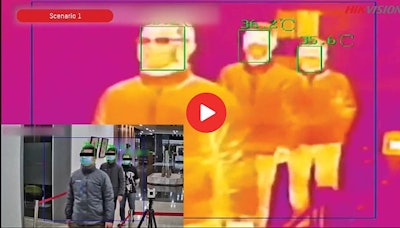
The new normal resulting from COVID-19 has meant changes in how poultry processing plants operate. Not all of the changes that will be needed are fully understood, however, we do know that we have to work with social distancing and will need to employ greater automation and increasingly adopt robotics.
Given that processing plants are the final link in the chicken production chain, strict hygiene and biosecurity measures have always been imperative. However, applying these measures, and adopting new ones, has become more important than ever to protect the health of workers and to keep businesses running.
Site access
Personnel must be carefully monitored every day.
In the same way that air passengers must go through a series of security checks before boarding flights, workers entering poultry processing plants must now also be checked – both for their reassurance and the companies.
The first worker biosecurity filter should be contactless temperature monitoring. On entering the premises, workers should pass through a tunnel or narrow cabin and be subjected to a thermographic camera that measures body temperature. The reading should be available in a maximum of two minutes.
Should an employee’s temperature be outside of the range of 97.7 - 98.6 °F, an alarm is triggered and a second reading must be taken. Should the initial data be confirmed, the individual will not be allowed to enter the premises and must leave via a separate route.
Special attention needs to be paid to truck drivers. Due to their repeated entry to the premises during a shift, they should be given their own, distinct, route into the plant, away from staff and other visitors. The risk status of where drivers have come from also needs to be established to ensure that they are not bringing infection into the processing plant.
At some processing plants, loaded trucks pass through disinfection ports, which brings multiple benefits. Disinfection ports not only help to disinfect but also clean the birds, their containers and the truck of any feces or other material that may have accumulated during transport. An additional benefit of the disinfection port is that the water used in the scalder will be cleaner than in those plants where a port is not used.
Respect zoning
The various operations conducted in the processing plants are carried out in distinct zones and these zones have varying levels of cleanliness.
The unloading and hanging areas, for example, have high levels of contamination, including feces, feathers and dust and are classed as very dirty, while the bleed tunnel, cladding and plucking areas are deemed dirty, with contaminants including fecal material and skin.
The evisceration area, where the intestines may break due to vent cutting and the removal of the intestinal package and viscera is classed as semi-dirty, while the chilling, deboning, cut up and packing areas should be impeccably clean.
To fully comply with biosecurity measures, some areas must be physically separated from others.
For example, in the unloading, hanging, slaughter and scalding areas, all of the equipment for hand and boot washing and disinfection should only be accessible to staff working in these areas.
The same must be the case in the evisceration area which should only be directly accessible. Other areas may be accessed via shared access routes but should have their own, separate, entrances.
Smart wristbands or bracelets can help to ensure that staff only access those areas that they have permission to access. Work areas should be kept as clean as possible.

Working conditions must be as clean as possible to protect staff and processed birds. | Eduardo Cervantes López
Automation and fewer workers
Depending on the speed at which the processing plant operates, cages or crates of broilers arriving for processing will be unloaded semi-automatically or automatically. Among the advantages of these approaches to unloading is that contact between workers and dirty cages is minimized.
The ongoing adoption of automation in the chicken processing sector has meant that there are fewer employees in the slaughter, scalding, plucking and evisceration operations. Because of this, the risk of infection with COVID-19 is reduced.
Additionally, it should be remembered that workers use, among other protections, hairnets, safety glasses and masks, gloves, aprons and boots. It should be noted, however, that where these items are reused, they must be thoroughly cleaned.
Those team members responsible for biosecurity at the plant must make sure that measures are systemically applied to ensure the protection of staff and processed chickens alike.
Lastly, to further minimize risks, plant managers must make sure that staff leaving the plant are subject to the same controls as when they entered it, as this will help to protect their families. Should there be an infection outbreak, investigations can then be carried out along the route from the plant and the workers’ home.
How to get the best out of poultry processing employees
www.WATTAgNet.com/articles/40500

















